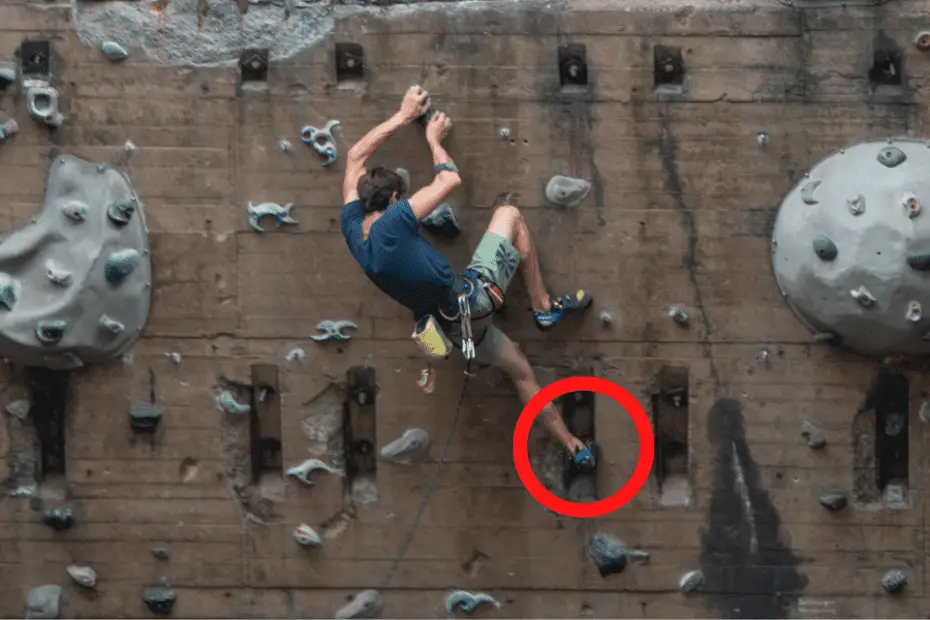“Dab!” The three-letter word that can strike fear into the heart of any climber. Not sure what it means? In this guide, I will answer the question of what is a dab in climbing and whether you should be worried about it.
What Is A Dab In Climbing?

Unlike the popular dance move of the twenty-tens, a dab in climbing has nothing to do with making it look like you are coughing or sneezing into your elbow.
A Dab is a term used in climbing and bouldering to describe a time when a climber touches a part of or something that is not part of the official climbing route.
What is classed as being not part of the climbing route varies depending on where you are climbing, but the most common items to touch and be called for a dab are:
- A hold on another part of the wall not classed as part of the offical course
- An anchor point on the course as these should not be used to assist in an official climb
- Touching a crash mat when starting or climbing low on the wall
- When outdoors, touching nearby trees or bushes
When Should I Call Out A Dab?
Knowing when to call out a dab is probably the most difficult part of watching someone climb, as it can quite often put the climber off.
Imagine being up a wall, using all your strength to hold yourself in position and having people shouting “Dab” at you. It could put you off what you are doing quite quickly, particularly if you are unsure what the dab is being called for.
When climbing in competition, calling out a dab is important as the climb will be void if the climber strays outside of the official route, but what about if you are climbing with friends? Should you call out every dab that they commit?
In my opinion, the best way to make sure that you don’t end up in a fight when calling a dab is to make sure you agree ahead of any climb when and when not to call out a dab. For instance, if your climbing partner is attempting a route for the first time it might be worth agreeing to call out if they gain a major advantage when using an unofficial part of the route, such as a tree or an adjacent hold, but maybe not calling out if their foot brushes against something.
Agree upfront and avoid a fight, simple!
Should I Worry About Dabbing When Climbing?

Dabbing is not the sort of thing that is actually going to hurt anyone if you do it, so you shouldn’t stress about it too much. That said it is still better to avoid it if you can. This is particularly important if you are climbing in a competition as a dab can mean the end of your climb and will most likely mean that the climb is deemed void.
The main thing to worry about is what is the cause of the dab in the first place. There are a few reasons that you are likely to dab when climbing that you should think about.
Poor Core Strength
Not having a strong core is probably the main cause of dabbing as you will find it difficult to stop your legs swinging out when climbing up a route. Engaging your core when you are climbing is key to maintaining control of your limbs.
If you feel that your core isn’t strong enough then focus on doing core workouts when you are not climbing.
Incorrect Footwear
Wearing the wrong shoes or shoes that have lost their grip is another cause of dabbing. If you are unable to get your foot on the required hold of the route and in the right position, the chances are that your foot will slip and you will end up touching something off-route to help you continue.
Make sure you choose the right footwear for the type and difficulty of the route you will be tackling.
Not Knowing The Route
Not knowing what is in bounds and out of bounds is also likely to lead to dabbing when climbing. Once you get quite high up on a climb, one of the main instincts you will have is to make sure you don’t fall too far. As a result, you are more likely to forget what is allowed and not allowed on the route you are climbing, particularly if you don’t know the climb well enough.
Study and discuss the route with a fellow climber before you set off to make sure you don’t stray from the route when you have nearly finished it.
A Better Description Of Dabbing In Climbing
The problem with dabbing in climbing is that it can get quite specific and quite frankly ridiculous as to what gets called out. Below are a couple of dabs that I have heard been called in the past:
- If my hair touched the crash mat, is that a dab?
- My foot accidentally touches a leaf on a nearby tree, is that a dab?
- I swat away a fly and touch it with my hand, is that a dab?
Ok, the last one is a bit of an exaggeration, but you get the idea. Sometimes we will inadvertently touch something that isn’t part of the official climbing route and it doesn’t provide us with any actual advantage, so should we call it a dab? In my opinion, no we shouldn’t.
For me a better description of a dab would be as follows:
A Dab is a term used in climbing and bouldering to describe a time when a climber touches a part of or something that is not part of the official climbing route and gains an advantage when doing so.
The key distinction here is that there is an advantage gained, which is the most important part. Who cares if my chalk bag touches the crash mat when I’m climbing? Unless it helps me in some way, I don’t think it should be called a dab.
Is This A Dab?
Below are some examples of what I believe should be called dabs and what shouldn’t be called dabs. Write in the comments below if you agree or disagree.
Definite Dab
- Hand or foot touches a hold not on the official climbing route, which helps the climber in some way
- Hand or foot touched anchor point, which helps the climber in some way
- Body-part touches something that is not part of the official climbing route, such as a tree, branch, bush, crashmat, etc.
- A large species of bird or other animal carries the climber to the end of the route!
No Way Is That A Dab
- Chalk bag touches something that is not part of the official climbing route
- Body part touches something that is not part of the official climbing route and no advantage is gained
- Hair or clothing touches something that is not part of the route
- The climber swats a fly whilst climbing
For some more info about dabbing in climbing, check out this video with some examples I’m climbing competitions.
Summary
So what do you think? Do you think you now know what a dab is when it comes to climbing? Do you think I have got something wrong about what should be called a dab and what shouldn’t be? Let me know what you think in the comments.
If you liked this guide, please share it on Pinterest. Also, please check out our other guides to all things outdoors.
Happy Climbing!



